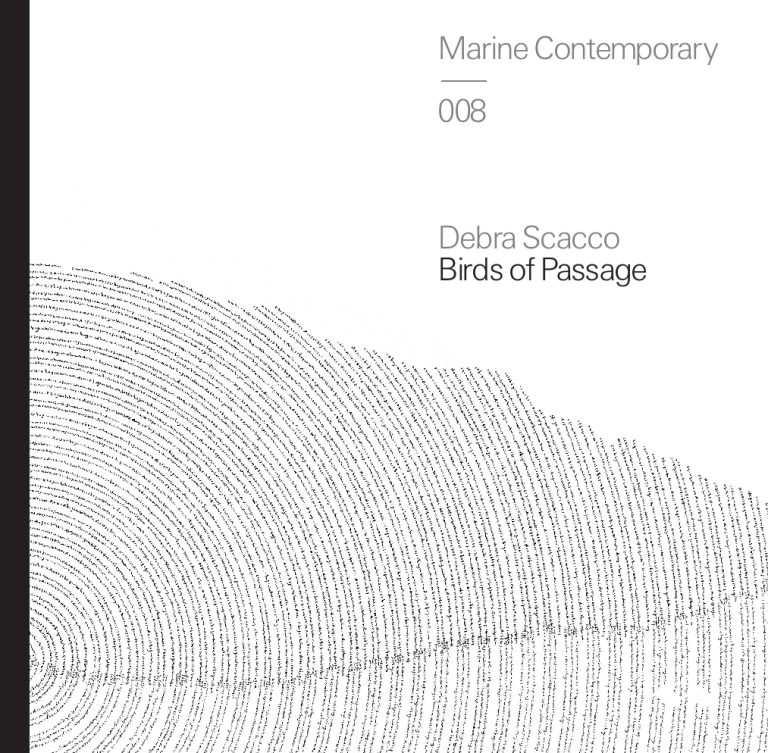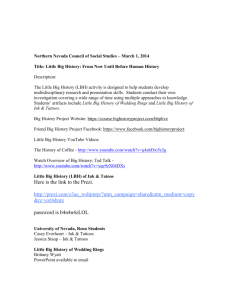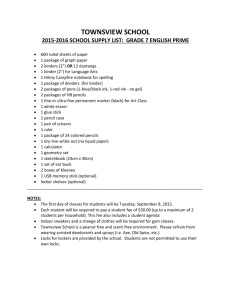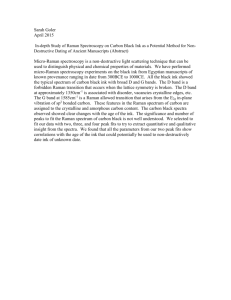
Marine Contemporary
008
Debra Scacco
Birds of Passage
Essay
Claressinka Anderson
There are not too many artists that have moved
me to tears in the presence of their work. Debra
Scacco is one of them. While conceptually raw,
deeply personal and often exceptionally poignant,
her work can be almost austere in its visual
minimalism. The two things, while somehow
incongruent, make for the perfect marriage, as
they allow the sentimentality of the work to be
offset by an ordered graphic language, that both
enhances the content and is simultaneously
disarming and unexpected.
Scacco’s practice is centered around the concept
of home. Born in 1970’s New York to an Italian
family, ethnic ties instilled in her both a devotion
to family in the truest sense and ownership of a
history not strictly her own. Her ties to Italian
culture result in a set of unattainable self-imposed
expectations, particularly in regard to her role as a
daughter and wife. These ties paired with
geographic displacement (first with her family for
southeastern America and later to establish her
own life in England) also mean that she is
perpetually in a transient state: in between places,
in between origins, in between roles and
ultimately in between the person she feels she
should be and the person she has become. The
result of this constant emotional flux is a lifelong
fixation with what home is and the seeming
impossibility of belonging.
The outcome of this fixation is a body of work
based on the artist’s personal diaries. Each piece
created from a sentence persistently repeated,
the obsessive text-based drawings attempt to
project a magical chimera. Intimate and
compulsive, the composition of the work from
a distance resembles dots or fragmented lines.
On closer inspection, word after word reveals
itself, creating an organic ebb and flow within a
rigid visual language. The works are both sombre
reflections over choices made throughout a
lifetime and contemplations on the future: all in
the hope of helping to discover what (or where)
is home.
How come the distance seems to grow is the first
of Scacco’s works to address the physicality of
this magical place. The piece depicts the artist’s
two home countries — the United States of
America and Great Britain — surrounded by
a sea of words that exemplifies both the vast
distance between them and the continual cycles
of mental and physical uncertainty caused by
constantly commuting from one to the other.
As if a stream of consciousness reproduces her
transatlantic journeys, the endless flow of the
sentence gradually forms the outlines of the
two countries. Seemingly infinite written lines
create folds and profiles between her homelands
which, like scars on the skin, indicate the special
emotional history that spans the space between.
The two countries themselves stand out from
the surging waves and remain untouched
— a blank space to stress their exceptional and
precious entity, but just as much to epitomize
the gravitational voids which Scacco is drifting
between.
Two countries, two homes, two blind spots.
Never able to fully fulfill her dream of a home at
one of the two places alone, she continuously
has to redefine the essence of this place with
each homecoming; trying to readjust or reassert
what has changed, faded or been erased since
the last visit.
While the literary content of Scacco’s work
remains consistent in its personal nature, the
visual content has evolved from a direct
manifestation of memory to a more abstract
pairing of words and graphic elements that
reference physical space. Her earlier works
were often directly grounded in her childhood
environment: the subject of each drawing
taking the form of childhood associations, such
as family furniture, textile patterns and the family
home itself. The idea of the house as home —
what that means — and the memories contained
within this shell, are all threads that continually
repeat throughout her work.
In a world that is continually changing, with each
new journey to a place once called home, comes
a newly reset impression: another temporary
moment demanding a changed perspective
again and again. The transitional area between
Scacco’s homes thus spreads to a metaphor of
home, one we are all trying to define and possibly
never can. It is an ever-changing ocean over
which thoughts travel, continually moulding itself
from the constantly growing distance traversed
in an effort to belong.
How come the distance seems to grow
Ink on paper 25” x 33”, 2008
You are heavy with memory
Ink on paper 25” x 21”, 2009
You are with me always I
Ink on paper 27” x 27”, 2009
I dream of coming back to you
(I dream you will come back to me)
Ink on paper 19” x 37” x 3”, 2010
Birds of Passage
For the last several years, Scacco has been
exploring her past in numerous ways: through
the interiors she has inhabited, through the
associations of certain objects and through the
interpretative view of her own memory. This
redrawing of her past was in many ways an
attempt to come to terms with the fact that she
feels different: someone other than who she is
supposed to be according to the rules of tradition.
As a result, Scacco has spent the best part of her
life drifting in search of something she will never
find. The impossibility of this search is attributed
to two key reasons: the home she continually
searches for is a place that exists only in her
own naïve memory and more importantly, the
choices she has made in her own life mean that
she will never allow herself the very environment
she seeks.
Scacco recurrently examines her past to try and
resolve issues of guilt, restlessness and lack of
belonging; issues that stem from not having
a home in the most conventional sense of the
term. What she has not yet addressed is what
this means in physical terms. She is continuously
fascinated by the notion of a place that exists
where everything is as it should be. As a result,
she felt the need to create a place wholly her own
- a kind of escapist utopia. But where is it? Can it
exist? Should she keep moving until she finds it?
This new body of work addresses these issues by
creating a world that blurs the boundaries of fact
and fiction. Although Scacco is shy as a person,
she is not afraid to expose deep vulnerabilities
through her work. This is what makes the work
so compelling in its honesty and beautiful in its
tentative and careful exploration of space.
Every element of Scacco’s work is carefully
considered, from the number of works chosen to
the words that contour the works themselves.
In this case, the core of the exhibition is
composed of seven large-scale maps, each in
some way referencing a geography significant
to the artist’s personal history. In each drawing of
these seven key territories, there is no sense of
scale - each is a nowhere place floating in white
space. In these seven places, there is always
a single fragmenting feature: something that
divides the city / state / country.
1. England (Thames River): where Scacco has
spent the majority of her adult life
2. Staten Island (Staten Island Expressway
System): where Scacco was born and partly
grew up
3. Georgia (Chattahoochee River): where Scacco
spent the remainder of her youth
4. Manhattan (Broadway): where Scacco’s father
emigrated to and she once lived
5. Sicily (Salso River): where Scacco’s father is from
6. Brooklyn (Brooklyn Queens Expressway):
where Scacco’s mother grew up and her
parents lived for many years
7. Calabria (Crati River): where Scacco’s maternal
grandfather comes from
Whether it be a river, highway, or borders
between countries, the way that geographies
fragment (and therefore determine where we
are “from”) are ultimately the first step in defining
us. So what happens when you’re not really
from anywhere? Who are you then? This is
why these territories could not be presented as
a solid whole.
According to Scacco, “The phrases for these
seven territories bring to light feelings on my
past.” They are: We do not belong, Traces are all I
have, All I ask is one more day, I owe everything,
Where does it begin, I cannot reach you, and I am
trapped in your shadow.
The circle as the key shape to populate these
territories was chosen for all it symbolizes: the
cartographic vernacular of “you are here”, the
idea of a continuous whole, the parallel between
the circle and endlessness. With each set of
circles existing within a square, Scacco has
reduced the framework of each drawing to the
most basic graphic elements.
Promise you will never fade away marks an
expanded focus: evolving the black and white
ink on paper drawings into layered watercolors,
incorporating text over a base painting. Used to
create an organic division between land and sea,
the paint takes on a loose and even slightly violent
quality: like stormy seas or inky tears on the page.
All of the painted pieces deal with the concept of
promise, as they are purely about fears of what
will happen in the future — fear of the new, fear of
loss, fear of change and in some ways, fear of the
future itself.
Birds of Passage is both literally and
metaphorically the central piece to the show.
The term “birds of passage” was used to refer to
early 20th century immigrants who traveled to
America in search of migratory labor. The intent
was always to return back to their homeland
permanently, but only a small percentage of
Italian immigrants did so. A three-dimensional
map, it sits in the center of the gallery, charting
the location and relationships between the
territories depicted in the drawings. This
installation work also incorporates the islands
from the purely fictional landscape as seen in
Promise you will never fade away: tying together
the fragmented real and wholly fictional to create
an imagined utopia. This sculpture is a shrine to a
place that can never exist. Made of approximately
4,000 intricately cut gold plated beads, it feels
protected, precious, untouchable.
The sea of cut gold sits on a white acrylic sheet,
inside a protective case. Reminiscent of the kind
of jewelry an Italian child may receive on their first
Communion, cuts in the gold allow light to play
throughout them, casting beautiful reflections;
the undulating sparkle becoming an illusory sea
that surrounds these fragile, isolated worlds.
Debra Scacco
(b. 1976, New York)
Lives and works in London, UK
Solo Exhibitions
2012
—Birds of Passage, Marine Contemporary,
Los Angeles, CA
2011
— Forever In Between, Marine Art Salon,
Los Angeles, CA
Selected Group Exhibitions
2012
— Incognito, Santa Monica Museum of Art,
Los Angeles
— Pieces of Heaven, Smashbox Studios,
Los Angeles (Benefit for Art of Elysium)
2011
— If these walls could talk: A conversation,
Charlie James Gallery and Marine Art Salon,
Los Angeles
—Incognito, Santa Monica Museum of Art,
Los Angeles
— Pieces of Heaven, Siren Studios,
Los Angeles (Vanity Fair benefit for Art
of Elysium)
2010 — Outside the Lines, Royale Projects,
Los Angeles — Royal Academy Summer Exhibition,
Royal Academy of Arts, London
— Gem, Gallery 825, Los Angeles — Salon No. 3, Marine Art Salon, Los Angeles
2009
— Follow Your Art, Royal Institute of
Great Britain (In association with Sotheby’s) — Jerwood Drawing Prize, Jerwood Space,
London (Followed by national tour through
2010)
— Salon No. 1, Marine Art Salon, Los Angeles
2008 —Postcards from the Edge,
James Cohan Gallery, NY — Allotment, Seven Seven Contemporary,
London
2005 — 70 Years of Penguin Design, V&A, London 2004
— Metamorphosis, Surface Gallery, Nottingham —La Isla, Teatro Odisséia, Rio de Janiero — Ocularis, Galapagos Art Space, New York — Carbonari, Florean Museum, Romania — Mesh, Seven Seven Contemporary, London 2003 — Signes de Nuit,Cinema Balzac, Paris — Reduced, Century Gallery, London — Viper Basel, Littmann Kulturprojekte,
Switzerland — Intervals, ATA, San Francisco — Arte Digital Rosario, Center de Expresiones
Contemporanias, Argentina — Covert, Whole Gallery, Baltimore — Mutiny, Oxo Tower, London
Collections and Corporate Showings
— The Media Centre, London
— The Florean Museum, Romania
— The Penguin Group, London
— Financial Dynamics, London
— Galerija Doma Vazduhoplovstva, Belgrade
— London Chamber of Commerce,
City of London
— International Art Consultants
(Art for Offices), London
Private collections throughout the UK and
America
Debra Scacco received a BA in Studio Art from
Richmond University (London, 1998). She
has exhibited widely in the UK and abroad,
including The Royal Academy Summer Show,
Jerwood Drawing Prize and Viper Basel (Basel,
Switzerland).
All I ask is one more day (Detail)
Ink on paper, 60” x 60”, 2011
All I ask is one more day
Ink on paper, 60” x 60”, 2011
Traces are all I have (Detail)
Ink on paper, 60” x 60”, 2011
Traces are all I have
Ink on paper, 60” x 60”, 2011
I owe everything (Detail)
Ink on paper, 60” x 60”, 2011
I owe everything
Ink on paper, 60” x 60”, 2011
We do not belong (Detail)
Ink on paper, 60” x 60”, 2012
We do not belong
Ink on paper, 60” x 60”, 2012
I am trapped in your shadow (Detail)
Ink on paper, 60” x 60”, 2012
I am trapped in your shadow
Ink on paper, 60” x 60”, 2012
I cannot reach you (Detail)
Ink on paper, 60” x 60”, 2012
I cannot reach you
Ink on paper, 60” x 60”, 2012
Where does it begin (Detail)
Ink on paper, 60” x 60”, 2012
Where does it begin
Ink on paper, 60” x 60”, 2012
Promise you will never fade away
Ink, watercolor and pigment on paper
48” x 60”, 2012
Promise you will never fade away (Detail)
Ink, watercolor and pigment on paper
48” x 60”, 2012
Promise you will never fade away (Detail)
Ink, watercolor and pigment on paper
48” x 60”, 2012
Remember me
Ink on paper, 11” x 11”, 2012
Hold me
Ink on paper, 11” x 11”, 2012
Remind me
Ink on paper, 11” x 11”, 2012
Find me
Ink on paper, 11” x 11”, 2012
Protect me
Ink on paper, 11” x 11”, 2012
Want me
Ink on paper, 11” x 11”, 2012
Love me
Ink on paper, 11” x 11”, 2012
Change me
Ink on paper, 11” x 11”, 2012
Need me
Ink on paper, 11” x 11”, 2012
Accept me
Ink on paper, 11” x 11”, 2012
Deserve me
Ink on paper, 11” x 11”, 2012
Birds of passage (Detail)
22K gold plated sterling silver beads, gold plated
head pins, epoxy, acrylic 4” x 22” x 44”, 2012
Birds of passage (Detail)
22K gold plated sterling silver beads, gold plated
head pins, epoxy, acrylic 4” x 22” x 44”, 2012
Birds of passage
Installation
Marine Contemporary 008
Debra Scacco: Birds of Passage
First Edition May 19, 2012
Los Angeles, CA
All images © Debra Scacco
All rights reserved. No part of this publication
may be duplicated or transmitted in any form
without written consent from Marine Contemporary.
Unauthorised broadcasting, copying or duplicating
of this publication or the works within it will constitute
an infringement of copyright.
Special thanks to Daniel Klemm for his writings on
How come the distance seems to grow.
Design: October
octoberdesign.co.uk
Debra Scacco.
Represented by Marine Contemporary.
marinecontemporary.com









